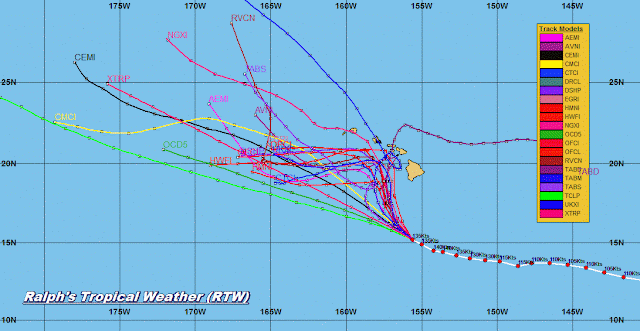Correct latest track.
WTPA32 PHFO 222048 TCPCP2 BULLETIN Hurricane Lane Advisory Number 33 NWS Central Pacific Hurricane Center Honolulu HI EP142018 1100 AM HST Wed Aug 22 2018 ...HAWAIIAN ISLANDS REMAIN VULNERABLE AS CATEGORY 4 HURRICANE LANE PASSES SOUTH OF THE BIG ISLAND... SUMMARY OF 1100 AM HST...2100 UTC...INFORMATION ----------------------------------------------- LOCATION...15.5N 155.9W ABOUT 285 MI...455 KM S OF KAILUA-KONA HAWAII ABOUT 420 MI...680 KM SSE OF HONOLULU HAWAII MAXIMUM SUSTAINED WINDS...155 MPH...250 KM/H PRESENT MOVEMENT...WNW OR 295 DEGREES AT 8 MPH...13 KM/H MINIMUM CENTRAL PRESSURE...935 MB...27.61 INCHES WATCHES AND WARNINGS -------------------- CHANGES WITH THIS ADVISORY: None. SUMMARY OF WATCHES AND WARNINGS IN EFFECT: A Hurricane Warning is in effect for... * Hawaii County * Maui County...including the islands of Maui, Lanai, Molokai and Kahoolawe A Hurricane Watch is in effect for... * Oahu * Kauai County...including the islands of Kauai and Niihau A Hurricane Warning means that hurricane conditions are expected somewhere within the warning area. A warning is typically issued 36 hours before the anticipated first occurrence of tropical-storm- force winds, conditions that make outside preparations difficult or dangerous. Preparations to protect life and property should be rushed to completion. A Hurricane Watch means that hurricane conditions are possible within the watch area. A watch is typically issued 48 hours before the anticipated first occurrence of tropical-storm-force winds, conditions that make outside preparations difficult or dangerous. Interests in the the Northwestern Hawaiian Islands should monitor the progress of Hurricane Lane. For storm information specific to your area, please monitor products issued by the National Weather Service office in Honolulu Hawaii. DISCUSSION AND OUTLOOK ---------------------- At 1100 AM HST (2100 UTC), the eye of Hurricane Lane was located near latitude 15.5 North, longitude 155.9 West. Lane is moving toward the west-northwest near 8 mph (13 km/h). A gradual turn toward the northwest is expected today followed by a more northward motion on Thursday. A turn back toward the west is expected on Saturday. On the forecast track, the center of Lane will move very close to or over the main Hawaiian Islands from Thursday through Saturday. Maximum sustained winds are near 155 mph (250 km/h) with higher gusts. Lane is a category 4 hurricane on the Saffir-Simpson Hurricane Wind Scale. A steady weakening trend is forecast to begin today, but Lane is expected to remain a dangerous hurricane as it approaches the islands. Hurricane-force winds extend outward up to 40 miles (65 km) from the center and tropical-storm-force winds extend outward up to 140 miles (220 km). The estimated minimum central pressure is 935 mb (27.61 inches). HAZARDS AFFECTING LAND ---------------------- WIND: Tropical storm conditions are expected within the Hurricane Warning area beginning late tonight into early Thursday morning, with hurricane conditions expected somewhere within the warning area on Thursday. Tropical storm conditions are possible within the Hurricane Watch area beginning Thursday into Thursday night, with hurricane conditions possible late Thursday night into Friday. RAINFALL: Rainbands from Hurricane Lane are moving ashore on the Puna and Kau districts. Excessive rainfall associated with Lane is expected to affect portions of the Hawaiian Islands from late today into the weekend. This could lead to major flash flooding and landslides. Lane is expected to produce total rain accumulations of 10 to 15 inches with localized amounts in excess of 20 inches over the Hawaiian Islands. SURF: Large swells generated by Lane will impact the Hawaiian Islands, spreading across the island chain today and tonight. These swells will produce very large and potentially damaging surf along exposed west, south and east facing shorelines. NEXT ADVISORY ------------- Next intermediate advisory at 200 PM HST. Next complete advisory at 500 PM HST. $$ Forecaster R Ballard
http://www.prh.noaa.gov/cphc/tcpages/?product=5day_cone_with_line&stormid=EP142018



























